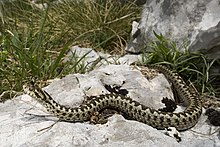Vipera ursinii
| Vipera ursinii | |
|---|---|

| |
| Scientific classification | |
| Domain: | Eukaryota |
| Kingdom: | Animalia |
| Phylum: | Chordata |
| Class: | Reptilia |
| Order: | Squamata |
| Suborder: | Serpentes |
| Family: | Viperidae |
| Genus: | Vipera |
| Species: | V. ursinii
|
| Binomial name | |
| Vipera ursinii (Bonaparte, 1835)
| |
| Synonyms[3] | |
| |
Vipera ursinii is a species of venomous snake in the subfamily Viperinae of the family Viperidae. It is a very rare species, which is in danger of extinction. This species is commonly called the meadow viper. It is found in France, Italy, and Greece as well as much of eastern Europe.[6] Several subspecies are recognized.[7] Beyond the highly threatened European population, poorly known populations exist as far to the east as Kazakhstan and northwestern China.
Etymology
The
Description
Adults of V. ursini average 40–50 cm (15.75–19.69 inches) in total length (including tail), although specimens of 63–80 cm (24.8–31.5 inches) in total length have been reported.
Common names
Meadow viper, Ursini's viper,[4] meadow adder,[5] Orsini's viper, field viper,[11] field adder.[12] Although the following subspecies are currently invalid according to the taxonomy used here, their common names may still be encountered:
- V. u. ursinii – Italian meadow viper.[11]
- V. u. macrops – karst viper,[11] karst adder.[5]
- V. u. rakosiensis – Danubian meadow viper.[11]
- V. renardi – steppe viper,[11] steppe adder, Renard's viper.[5]
- V. u. moldavica – Moldavian meadow viper.
Geographic range
Southeastern
Vipera ursinii rakosiensis is native to Hungary[14] although the taxonomic status of this subspecies is disputed (see section "Taxonomy")
The
Conservation status
The species Vipera ursinii is considered to be a
In addition, this species is listed on
V. ursinii is the most threatened snake in Europe. At least 12 human activities are threatening these animals: 1. Grazing 2. Mowing 3. Fire 4. Agriculture 5. Roads 6. Constructions 7. Leisure Activities 8. Afforestation 9. Cynegetic species management 10. Persecution 11. Illegal collection 12. Littering
Taxonomy
There is high genetic diversity within samples of Vipera ursinii and several species may be involved. At least six subspecies may be encountered in modern literature:[3]
- Vipera ursinii ursinii (Bonaparte, 1835)
- Vipera ursinii eriwanensis (A.F. Reuss, 1933)
- Vipera ursinii graeca Nilson & Andrén, 1988
- Vipera ursinii macrops Méhelÿ, 1911
- Vipera ursinii moldavica Nilson, Andrén & Joger, 1993
- Vipera ursinii rakosiensisMéhely, 1893
- Vipera ursinii renardi Christoph, 1861
Notes
- ^ Only populations of Europe, except areas that formerly constituted the USSR (populations in that area, and all other areas, are not included in the Appendices.
References
- ^ doi:10.2305/IUCN.UK.2009.RLTS.T22997A9406628.en. Retrieved 19 November 2021.)
{{cite journal}}: CS1 maint: multiple names: authors list (link - ^ "Appendices | CITES". cites.org. Retrieved 2022-01-14.
- ^ ISBN 1-893777-01-4(volume).
- ^ ISBN 0-89464-877-2.
- ^ ISBN 0-398-02808-7.
- ^ "Snakes in France". Planete Passion.
- S2CID 83492151.
- ^ Bonaparte, Carlo Luciano (1835). Iconografia della fauna italica per le quattro classi degli animali vertebrati. Tomo 2. Amfibi. Rome: Salviucci. pages unnumbered. (Pelias Ursinii, new species). (in Italian).
- ISBN 978-1-4214-0135-5. (Vipera ursinii, p. 196).
- ISBN 0-00-219318-3. (Vipera ursinii, pp. 215–217 + Plate 39 + Map 121).
- ^ ISBN 0-8386-1023-4.
- ^ Hellmich W (1962). Reptiles and Amphibians of Europe. London: Blandford Press. Translated from Winter C (1956). Die Lurche und Kriechtiere Europas. Heidelberg, Germany: Universitatsverlag, gegr. 1822, GmbH.
- ^ Jelić, Dušan; Ajtic, Rastko; Sterijovski, Bogoljub; Crnobrnja-Isailovic, Jelka; Lelo, Suvad; Tomović, Ljiljana (2013-01-31). "Distribution of the genus Vipera in the western and Central Balkans (Squamata, Serpentes, Viperidae)". Herpetozoa. 25: 109–132.
- ^ Leírás. Fertő-Hanság Nemzeti Park (Fertő-Hansag National Park of Hungary)
- ^ Vipera ursinii Archived 2009-08-14 at the Wayback Machine at CITES and United Nations Environment Programme / World Conservation Monitoring Centre. Accessed 8 October 2006.
- ^ Convention on the Conservation of European Wildlife and Natural Habitats, Appendix II at Council of Europe. Accessed 9 October 2006.
Further reading
- Golay P, Smith HM, Broadley DG, Dixon JR, McCarthy CJ, Rage J-C, Schätti B, Toriba M (1993). Endoglyphs and Other Major Venomous Snakes of the World: A Checklist. Geneva: Azemiops.
- ISBN 0-916984-22-2. (Vipera ursinii, p. 133.)
External links
- Vipera ursinii at the Reptarium.cz Reptile Database. Accessed 2 September 2007.
- Meadow viper (Vipera ursinii ) at ARKive. Accessed 5 October 2006.
- Vipera ursinii at Amphibians and Reptiles of Europe. Accessed 9 October 2006.
- Orsini's viper, Vipera ursinii at Reptiles & Amphibians of France. Accessed 30 October 2006.
- ZAMFIRESCU, Stefan; STRUGARIU, Alexandru; GHERGHEL, Iulian; ZAMFIRESCU, Oana. "HUMAN IMPACT ON HABITATS OF THE MEADOW VIPER (VIPERA URSINII) IN EASTERN ROMANIA" (PDF). Iasi University, Faculty of Biology. Retrieved 5 April 2016.
- Vipera eriwanensis at Checklist of Armenia's Amphibians and Reptiles, Tadevosyan's Herpetological Resources. Accessed 30 March 2007.

